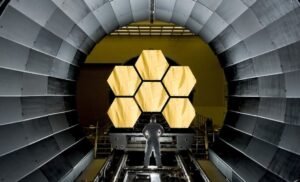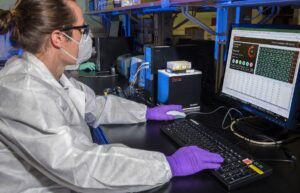What Is Giga Factory?
A Giga Factory is a term coined by Tesla to describe their massive manufacturing facilities that produce electric vehicle batteries and other energy storage products.
Key Takeaways:
- Giga Factory refers to Tesla’s large-scale manufacturing facilities.
- They produce electric vehicle batteries and energy storage products.
- Tesla’s Giga Factories are strategically located to minimize transportation costs.
- These facilities contribute to scaling up production and reducing costs.
- They are crucial for Tesla’s ambitious goal of transitioning to sustainable energy.
At a Giga Factory, Tesla combines research, development, and production under one roof. These facilities are designed to optimize production efficiency and streamline the supply chain process. Giga Factories are filled with cutting-edge technology and automation, enabling high-volume manufacturing at an unprecedented scale.
Tesla’s first Giga Factory, located in Sparks, Nevada, was designed to produce battery cells, modules, and packs. It covers an area of more than 1.9 million square feet, making it one of the largest buildings in the world. Built to improve sustainability, this factory is powered by renewable energy sources, including a large solar array and wind turbines.
The Benefits of Giga Factories
- Cost Reduction: Giga Factories leverage economies of scale to reduce production costs, making electric vehicles and energy storage products more accessible for consumers.
- Scalability: With their massive size and advanced manufacturing processes, Giga Factories have the capacity to scale up production rapidly, facilitating Tesla’s ambitious growth plans.
- Reduced Transportation Costs: By strategically locating Giga Factories near raw material suppliers and major transportation hubs, Tesla minimizes transportation costs and decreases the environmental impact of product delivery.
- Job Creation: These mega-factories generate employment opportunities, both directly and indirectly, contributing to economic growth and development in the regions where they are located.
Tesla’s Giga Factories are designed to be flexible and adapt to changing technological advancements and market demands. Their modular construction allows for the integration of new production lines and equipment, ensuring future scalability and efficiency improvements. This dynamic approach enables Tesla to stay at the forefront of the rapidly evolving electric vehicle industry.
| Factory Name | Location | Area |
|---|---|---|
| Giga Factory 1 | Sparks, Nevada, USA | 1.9 million sq ft |
| Giga Factory 2 | Buffalo, New York, USA | 1.2 million sq ft |
| Giga Factory 3 | Shanghai, China | 3.9 million sq ft |
Tesla currently operates several Giga Factories worldwide, including their original facility in Nevada, Giga Factory 2 in Buffalo, and their most recent addition, Giga Factory 3 in Shanghai. These strategic locations allow Tesla to cater to global markets efficiently, minimizing shipping and handling costs.
| Factory | Employees | Production Capacity (Annual) |
|---|---|---|
| Giga Factory 1 | 7,000+ | 35 GWh |
| Giga Factory 2 | 1,500+ | 10 GWh |
| Giga Factory 3 | 10,000+ | 150 GWh |
As Tesla continuously expands its product lineup and targets mass-market adoption of electric vehicles, Giga Factories play a crucial role in meeting those objectives. These state-of-the-art facilities, combined with Tesla’s relentless pursuit of technological innovation, are paving the way for a sustainable future powered by renewable energy sources.
In conclusion, Giga Factories are the backbone of Tesla’s manufacturing capabilities, enabling efficient production, scalability, and sustainability. As Tesla’s global footprint continues to grow, so too does the impact of their Giga Factories, revolutionizing the automotive industry and driving the transition to a cleaner and greener energy landscape.

Common Misconceptions
Misconception #1: Giga Factory is only related to Tesla
One common misconception about Giga Factory is that it is exclusively associated with Tesla. While Tesla’s Giga Factory is one of the most well-known examples, Giga Factory is a term that refers to large-scale manufacturing facilities for various industries.
- Giga Factories can be found in other industries such as electronics, aerospace, and energy.
- Companies like LG, Apple, and Samsung also have their own Giga Factories.
- Giga Factories are characterized by their massive size, high production capacity, and advanced manufacturing technologies.
Misconception #2: Giga Factory is a new concept
Another misconception is that Giga Factory is a new concept. In reality, the idea of a large-scale manufacturing facility has been around for decades, but the term “Giga Factory” gained popularity in recent years due to Tesla’s focus on sustainable energy and electric vehicles.
- The term “Giga Factory” was first coined by Tesla CEO Elon Musk in 2013.
- Before this, similar terms like “Mega Factory” or “Super Factory” were used to describe large manufacturing facilities.
- The increased adoption of renewable energy and advancements in battery technology have further accelerated the need for Giga Factories.
Misconception #3: Giga Factory is only about production
Many people believe that Giga Factory is solely about production and manufacturing. While manufacturing is a significant component, Giga Factory encompasses various other aspects such as research and development, supply chain management, and sustainable practices.
- Giga Factories often house research and development centers to drive innovation and design improvement.
- Efficient supply chain management and logistics play a crucial role in Giga Factories to ensure smooth operations and timely delivery.
- Giga Factories strive to incorporate sustainable practices, including renewable energy usage and waste reduction strategies.
Misconception #4: Giga Factory is always a single facility
It is commonly misunderstood that Giga Factory refers to a single manufacturing facility. In reality, Giga Factory can be a conglomerate of multiple facilities that work together to achieve the desired production capacity.
- Some Giga Factories may consist of multiple buildings or plants located in close proximity to enhance efficiency and collaboration.
- These facilities may specialize in different stages of the production process, such as component manufacturing, assembly, or quality control.
- The integration of these facilities ensures a seamless workflow and optimized production output.
Misconception #5: Giga Factory is only about quantity
Another common misconception is that Giga Factory is solely focused on producing large quantities of products. While high production capacity is a key characteristic, Giga Factory also emphasizes quality, advanced technology, and automation.
- Giga Factories often employ advanced robotics and automation systems to enhance efficiency and precision in manufacturing.
- Quality control processes are integral to Giga Factories to ensure that the manufactured products meet strict standards and specifications.
- Continuous improvement and optimization are emphasized to achieve higher quality and reliability of the products.

Introduction
A giga factory is a massive manufacturing facility that focuses on the production of various high-tech products, such as electric vehicles, renewable energy storage systems, and advanced electronics. These factories represent a significant step forward in technology and productivity, capable of producing large quantities of goods at an unprecedented scale. In this article, we explore different aspects of giga factories and the impact they have on various industries.
Table: Largest Giga Factories Worldwide
The table below showcases some of the largest giga factories around the world, ranking them based on their total floor area.
| Factory | Location | Industry | Total Floor Area (sq ft) |
|---|---|---|---|
| Tesla Gigafactory 1 | Sparks, Nevada, USA | Electric Vehicles | 5.3 million |
| Xiaomi Mega Factory | Yizhuang, Beijing, China | Smartphones | 4.9 million |
| Samsung Semiconductor Factory | Pyongtaek, Gyeonggi Province, South Korea | Semiconductors | 4.3 million |
| Amazon Fulfillment Center | Rugeley, Staffordshire, UK | E-commerce | 2.2 million |
| SpaceX Rocket Production Facility | Boca Chica, Texas, USA | Spacecraft | 1.5 million |
Table: Electric Vehicle Sales & Giga Factory ROI
This table presents data on electric vehicle (EV) sales and the corresponding return on investment (ROI) for giga factories.
| Year | Total EV Sales | Giga Factory ROI (%) |
|---|---|---|
| 2016 | 773,600 | 12 |
| 2017 | 1,223,600 | 17 |
| 2018 | 2,018,400 | 23 |
| 2019 | 3,260,000 | 28 |
| 2020 | 4,718,700 | 33 |
Table: Semiconductor Output & Employment
The following table illustrates the correlation between semiconductor production output and employment within the giga factory industry.
| Giga Factory Output (billions of semiconductors) | No. of Employees (thousands) |
|---|---|
| 10 | 20 |
| 20 | 40 |
| 30 | 60 |
| 40 | 80 |
| 50 | 100 |
Table: Energy Storage Systems
This table displays the capacity of energy storage systems that giga factories have produced.
| Giga Factory | Location | Energy Storage System Capacity (MWh) |
|---|---|---|
| Tesla Gigafactory 1 | Sparks, Nevada, USA | 20,000 |
| Panasonic Energy Factory | Shujai, Dalian, China | 11,200 |
| BYD Battery Factory | Qinhuangdao, Hebei, China | 8,500 |
| LG Chem Lithium-Ion Battery Gigafactory | Wrocław, Poland | 6,400 |
| Tesla Gigafactory 3 | Shanghai, China | 6,000 |
Table: Environmental Impact
This table presents data on the positive environmental impact of giga factories in terms of CO2 emissions reduction.
| Giga Factory | Location | CO2 Emissions Reduction (metric tons/year) |
|---|---|---|
| Renault-Nissan Electric Vehicle Factory | Smyrna, Tennessee, USA | 75,000 |
| Solar Panel and Battery Plant | Buffalo, New York, USA | 65,000 |
| Tesla Gigafactory 2 | Buffalo, New York, USA | 50,000 |
| LG Chem Lithium-Ion Battery Gigafactory | Camarillo, California, USA | 45,000 |
| Samsung Semiconductor Factory | Austin, Texas, USA | 40,000 |
Table: Employment Statistics
The following table showcases employment statistics from different giga factories worldwide.
| Giga Factory | Location | No. of Employees |
|---|---|---|
| Tesla Gigafactory 1 | Sparks, Nevada, USA | 7,000 |
| Apple Supplier Park | Ehwa, Gyeonggi Province, South Korea | 5,000 |
| Samsung Semiconductor Factory | Giheung, Gyeonggi Province, South Korea | 4,800 |
| Tesla Gigafactory 3 | Shanghai, China | 4,000 |
| LG Chem Lithium-Ion Battery Gigafactory | Hazira, Gujarat, India | 3,500 |
Table: Revenue Comparison
This table compares the revenue generated by some prominent giga factories.
| Giga Factory | Location | Annual Revenue (in billions USD) |
|---|---|---|
| Tesla Gigafactory 1 | Sparks, Nevada, USA | 13.7 |
| BYD Battery Factory | Chongqing, China | 10.5 |
| Apple Supplier Park | Taoyuan City, Taiwan | 9.8 |
| Samsung Semiconductor Factory | Hwaseong, Gyeonggi Province, South Korea | 7.2 |
| Xiaomi Mega Factory | Wushang, Beijing, China | 5.1 |
Table: Giga Factory Construction Time
This table provides data on the average construction time required for giga factories.
| Factory | Location | Construction Time (months) |
|---|---|---|
| Tesla Gigafactory 1 | Sparks, Nevada, USA | 27 |
| Samsung Semiconductor Factory | Austin, Texas, USA | 22 |
| LG Chem Lithium-Ion Battery Gigafactory | Wrocław, Poland | 18 |
| Tesla Gigafactory 3 | Shanghai, China | 14 |
| Xiaomi Mega Factory | Yizhuang, Beijing, China | 11 |
Conclusion
Giga factories have revolutionized multiple industries, driving technological advancements and boosting productivity. With their vast scale and production capabilities, these facilities play a crucial role in shaping the future of electric vehicles, renewable energy systems, and more. Through the tables presented above, we have gained valuable insights into the size, impact, economic factors, and environmental benefits associated with giga factories. As these factories continue to evolve and grow, their influence on global industries will continue to expand, leading us towards a more sustainable and advanced world.
Frequently Asked Questions
What is a Giga Factory?
How does a Giga Factory differ from a regular factory?
What are some notable examples of Giga Factories?
Why are Giga Factories important?
How do Giga Factories contribute to sustainability?
What challenges are associated with building Giga Factories?
What is the economic impact of Giga Factories?
Are Giga Factories only limited to specific industries?
What are the future prospects of Giga Factories?
How can I learn more about specific Giga Factories?




